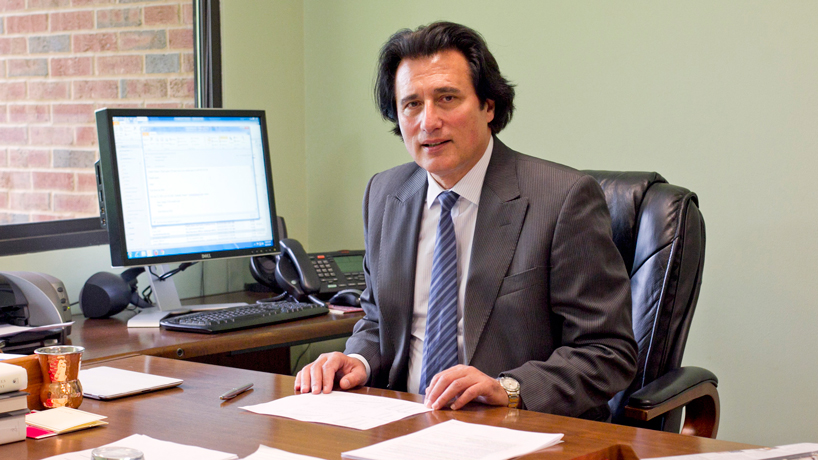
Nasser Arshadi, vice provost for research at UMSL, will oversee the UMSL side of the project. (Photo by August Jennewein)
The John D. and Catherine T. MacArthur Foundation today announced that St. Louis County is one of 20 jurisdictions selected to receive a $150,000 grant to create a fairer, more effective local justice system. The grant is a part of the Safety and Justice Challenge, the Foundation’s $75 million initiative to reduce over-incarceration by changing the way America thinks about and uses jails. With the support, St. Louis County and the University of Missouri–St. Louis will develop a municipal court coordinating office to standardize fine amounts and bond payments across the jurisdiction, reduce bench warrants and subsequent incarceration, and educate citizens about the legal process and individual rights.
The STL County/UMSL project was chosen following a highly competitive selection process that drew applications from nearly 200 jurisdictions from 45 states. The Safety and Justice Challenge competition supports jurisdictions across the country seeking to create more just and effective local justice systems that improve public safety, save taxpayer money and yield better outcomes. The 20 selected jurisdictions will work with expert consultants to develop a plan for local justice system improvement. In 2016, as many as 10 of these jurisdictions will receive a second round of funding – between $500,000 to $2 million annually – to implement their plans over two years.
“Nearly 200 diverse jurisdictions responded to our challenge, reflecting nationwide interest in reducing over-incarceration,” said Julia Stasch, president of the MacArthur Foundation. “Each of the sites selected has demonstrated the motivation, collaboration and commitment needed to make real change in their local justice systems. We hope their local efforts will model effective and safe alternatives to the incarceration status quo for the rest of the country.”
“There is a significant pent-up demand in the region for justice reform through standardizing fine amounts and bond payments across jurisdictions, reducing reliance on jails for non-violent crimes, and improving policing and community relations,” said Nasser Arshadi, vice provost for research at UMSL. “In the process, the jurisdiction will be able to improve public safety, save taxpayer money and lead to better social outcomes.”
Despite growing national attention to the large number of Americans confined in state and federal prisons, significantly less attention has been paid to local justice systems, where the criminal justice system primarily operates and where over-incarceration begins. Jail populations have more than tripled since the 1980s, as have cumulative expenditures related to building and running them. According to recent research from the Vera Institute of Justice, nearly 75 percent of the population of both sentenced offenders and pre-trial detainees are in jail for nonviolent offenses such as traffic, property, drug, or public order violations. Furthermore, low-income individuals and communities of color disproportionately experience the negative consequences of incarceration.
St. Louis County consists of 90 municipalities including Ferguson. Of these, 82 operate their own municipal courts, 32 run their own jails, and 63 have their own police departments. The overuse of jails is driven by multiple modifiable factors: 1) each municipal court, jail and police department operates independently; 2) unnecessary incarceration for municipal offenses; 3) inconsistent and often harsh bonding practices; 4) restrictive state statutes; 5) limited County-wide alternatives to jailing; and 6) shortage of mental-health resources. The St. Louis County jail’s capacity is 1,232 but regularly exceeds 1,300 inmates.
Information about the selected jurisdictions, as well as news, research, and events related to the Safety and Justice Challenge, will be published on www.SafetyandJusticeChallenge.org.
About the MacArthur Foundation
The MacArthur Foundation supports creative people and effective institutions committed to building a more just, verdant and peaceful world. In addition to selecting the MacArthur Fellows, the Foundation works to defend human rights, advance global conservation and security, make cities better places, and understand how technology affects children and society. More information about the Foundation’s work, including in the justice field, is available at www.macfound.org.
About St. Louis County
St. Louis County, a 523-square mile area with a population of 1 million people in 2010 (according to U.S. Census Bureau), is the most populous county in Missouri. It borders the City of St. Louis, which separated itself from the County in 1877 creating an independent city that as of 2010 has a population of over 300,000. Both St. Louis County and St. Louis City are included in the St. Louis Metropolitan Statistical Area, which had a population of nearly 2.8 million in 2010. St. Louis County government is divided between the St. Louis County Council and the County Executive of St. Louis County (currently Steve Stenger, elected in November 2014), who functions in a mayoral capacity. In addition to county-level government, there are 90 municipal governments in St. Louis County. The County manages a large jail population and comprehensive community corrections system; has a history of developing alternatives to incarceration; and contracts with many of the municipalities to house inmates, develop a mental health court, and design alternative-to-incarceration community service programs. St. Louis County has pledged the commitment and time of key County leaders to this reform effort.
About the University of Missouri–St. Louis
With a diverse body of more than 17,000 students, the University of Missouri–St. Louis is the largest public research university in the area and the third largest in Missouri. It offers 47 undergraduate degree programs, 29 master’s degree programs and 13 doctoral degree programs. The Department of Criminology and Criminal Justice is ranked 2nd nationally by the Journal of Criminal Justice for scholarly research. More information about UMSL can be found at umsl.edu
Media Coverage:
St. Louis Post-Dispatch
St. Louis Public Radio
“We Live Here” on St. Louis Public Radio
Huffington Post














